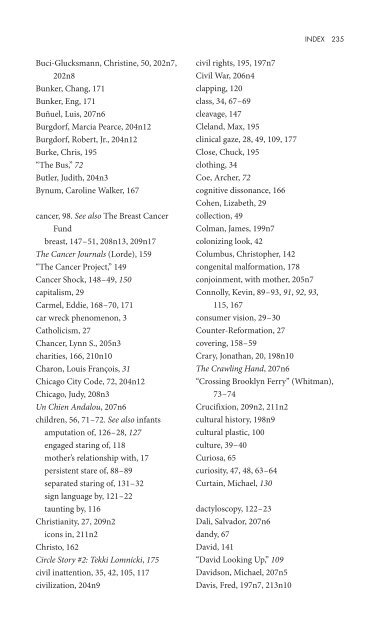Staring how we look sobre la mirada.pdf - artecolonial
Staring how we look sobre la mirada.pdf - artecolonial
Staring how we look sobre la mirada.pdf - artecolonial
Create successful ePaper yourself
Turn your PDF publications into a flip-book with our unique Google optimized e-Paper software.
FACES 113<br />
Although they are genetically identical, as are all conjoined twins, Reba is<br />
significantly smaller and does not walk as a result of spina bifida. One of<br />
the resourceful adaptations they have devised to live together in a world<br />
built for other embodiments is for Reba to sit on a kind of rolling bar stool<br />
that is propelled by the sturdier Lori as she moves along. Attached and<br />
identical as they are, Reba and Lori have quite different temperaments,<br />
aspirations, and tastes. Reba, the feistier of the sisters, is a redheaded country<br />
and <strong>we</strong>stern singer with a fierce sense of independence, although not<br />
from Lori. Lori, with her simple brown haircut and sensible shoes, wants<br />
to work in a hospital and have a family. Although they imagine different<br />
careers, lifestyles, and pleasures, neither woman questions their fleshly or<br />
familial attachment to one another. There is not a hint of drama here about<br />
the question of surgical separation. They are committed to accommodating<br />
one another in ways that go beyond the imagination of any pair of<br />
ordinary singleton partners. 7 Their conjoinment is an opportunity for resourceful<br />
adaptability that those of us for whom the world is conveniently<br />
structured could hardly imagine.<br />
Lori and Reba do extreme face-work in the film. The twins cruise through<br />
the public realm with great poise, confidence, and good cheer, narrating<br />
their own lives, experience, and opinions. Their myriads of first-time vie<strong>we</strong>rs,<br />
<strong>how</strong>ever, are a<strong>we</strong>struck, stopped in their tracks with mouths agape and<br />
eyes out of control. The twins are virtuosos of every face-work strategy that<br />
Partridge or Goffman describe. They anticipate and maneuver staring encounters,<br />
often instructing starers <strong>how</strong> to handle themselves appropriately.<br />
The twins seldom adopt the didactic <strong>la</strong>rgess of David Roche, but instead<br />
they save face for their gawkers by pragmatically easing them away from<br />
frozen astonishment or maudlin sentiments, which always end in mutual<br />
embarrassment. Reba, for instance, brandishes a tourist’s camera that she<br />
uses to stare back at her visual interlocutors, but at the same time she firmly<br />
informs people who try to take pictures of her and Lori that they must obtain<br />
Lori’s permission to be photographed, then adds that because she is a<br />
country singer, they are free to photograph her as if she <strong>we</strong>re a celebrity. 8<br />
With some indulgence and often strained patience, the twins let us know<br />
that they understand their starers’ loss of composure and social grace as<br />
simply ignorance about the intricacies of human variation and of alternative<br />
ways of being in the world.<br />
The film’s project is to make the vie<strong>we</strong>rs—like the starers it s<strong>how</strong>s—comfortable<br />
with the Schappell twins by presenting them as regu<strong>la</strong>r people<br />
getting through their day (figure 8.3). The twins relish being a spectacle,<br />
making a virtue out of necessity as does Roche. All three cultivate a certain<br />
celebrity that comes to them from transforming unwanted attention<br />
into effective face-work. Reba and Lori maintain face by taking pleasure in


